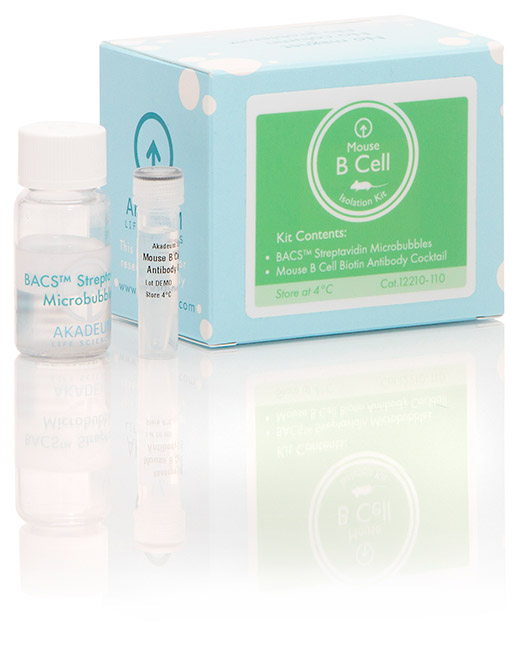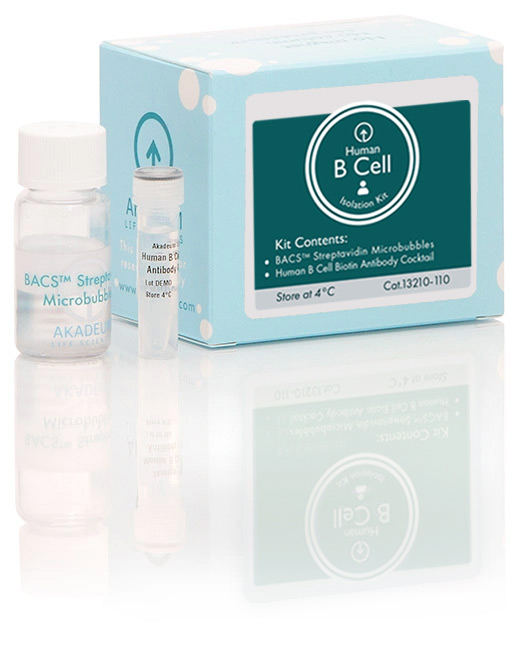View our Buoyant Microbubble Cell Separation Products
B Cell Isolation Products
Akadeum’s microbubble-based B cell isolation products are a revolutionary way to approach cell sorting. Our buoyancy-activated cell sorting (BACS™) technology is an innovative alternative to traditional B cell isolation protocols—reducing costs, saving time, and simplifying workflows while improving the purity and viability of sorted cells.
Available B Cell Isolation Kits and Solutions
Our line of B cell isolation products includes microbubble cell separation kits for mouse cells. We also have an available human B cell isolation kit. We are continually updating our product line with BACS™ technology, but if you don’t see what you’re looking for, contact us.
What Are B Cells?
B cells are one of the two major types of lymphocytes, the other being T cells. B cells are derived from hematopoietic stem cells in the bone marrow and progress through several stages of maturation in the bone marrow and spleen.
A critical step in B cell maturation is the development of the B cell receptor (BCR). A particular B cell will produce just one type of BCR. This BCR can recognize and bind to a specific antigen. Since mature B cells express just one type of BCR that recognizes a particular antigen, it is important to have a myriad of B cells encompassing a vast repertoire BCRs to ensure that antigens from a variety of pathogens can detected and trigger the appropriate immune response.
The incredible diversity in BCR specificity is accomplished through a process known as V(D)J recombination, which randomly assembles segments of the genes that are responsible for generating the BCR. Upon binding of the BCR to an antigen, naïve B cells can become activated and differentiate into antibody-producing plasma cells and memory B cells. Secretion of antibodies by these cells represents the humoral portion of adaptive or acquired immunity. In addition to generating and secreting antibodies, B cells also present antigens to T cells, thereby promoting a T cell response.
What Is B Cell Isolation?
Cell isolation is when a single cell type, such as B cells, is separated from other cell populations in a biological sample.
Be cells at various stages of maturation or activation can be identified by cell surface markers. Some of the most commonly used markers to identify B cells are CD19, CD20, and CD138. Isolation products commonly use cell surface markers to isolate target cells from unwanted cells.
Isolating high purity B cells is an important part of cell preparation and research. The presence of high quantities of other cell types may alter the function of B cells, interfere with downstream assays, or add noise to an experiment making it difficult to obtain meaningful results.
Types of B Cell Isolation Protocols
There are several cell isolation technologies that can be used to separate B cells from unwanted cell populations:
- Fluorescence-activated cell sorting (FACS)
- Density gradient centrifugation
- Magnetic-activated cell sorting (MACS)
- Filtration
- Aptamer-based cell isolation
The isolation protocol researchers use determines the quality of B cell populations and, ultimately, the accuracy of studies on those populations. However, these approaches are often expensive, require several centrifugation steps, leave behind residual cells that can negatively impact the final product.
But don’t worry. There is a better solution: Microbubbles are here to help.
What Is the Best Way to Isolate B Cells?
Microbubbles are an excellent choice for researchers looking to reduce costs, time, and errors when isolating B cells. Our BACS™ technology captures unwanted cells and quickly floats them to the surface of a liquid sample for removal.
Cost savings? Easy. No magnet or column required. In fact, no additional equipment needed at all.
How about time? Akadeum microbubble technology is easy to use, and the entire process takes just 35 to 40 minutes.
But what about cell viability and purity? Microbubbles have a limited negative effect on cell viability, and they isolate targeted cells to a high level of purity.
I need gentle cell sorting. Can you do that? Yes, we can. Our technology offers a gentler cell separation approach, with no harsh magnetic forces. Just microbubbles.
Try an Akadeum B Cell Isolation Kit
Akadeum B cell isolation kits are a simple, effective way to separate B cells from unwanted cells in a biological sample.
Here’s how it works: Unwanted cells are labeled with biotinylated antibodies and mixed with microbubbles. Then, the microbubbles bind to the antibodies on the surfaces of the unwanted cells and float those cell populations to the top of the sample. The result is high purity, unaltered B cells ready for downstream applications.
Why wait? Try our BACS™ microbubble technology today.




